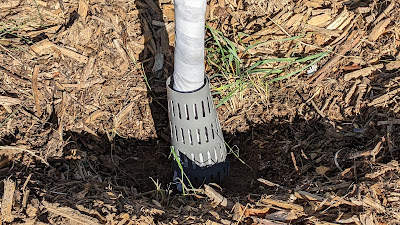What is June Drop?
June drop is a phenomenon that occurs in late spring, where fruit trees self thin by dropping immature fruit. June drop can occur for many reasons, but it is often a result of not enough light reaching the leaves that feed the developing fruit. June drop is not a replacement for fruit thinning and June drop can also indicate improper pruning or other deficiencies that should be mitigated.
 |
| Click Image to Zoom |
Just because June drop is called June drop, doesn't mean that this phenomenon only occurs in June. Where I live, May showers bring June flowers and June drop happens in July. June drop might not always happen in June, but it is safe to say that June drop occurs in late spring whenever that looks like in your climate. For some of you that might mean February.
June drop occurs when your fruit trees recognize all or a portion of the fruit that it is developing as a liability rather than an asset. If your fruit tree is under some sort of stress, it will decide that it needs to conserve resources to survive and it will abort the partially developed fruit. Drought, nutrient imbalance, disease, and lack of sunshine can all contribute to June drop.If you are enjoying this article and would like more like it, please subscribe here:
Some gardeners avoid thinning fruit because experience has shown them that the tree will do it all by itself. With proper pruning you will find that your tree will not abort immature fruit and you will still need to do a heavy thinning.
If your tree has been pruned correctly and it still loses fruit in in the late spring, then you may need to find out what is causing the drop and try to fix the problem. Is your tree shaded by other trees? Is the ground dry under the canopy? Do you have any pests or disease?
If your tree is pruned correctly and it is still not getting enough light due to other trees, or man made structures, then there is not much you can do to correct this problem. Fruit trees need a lot of light to produce fruit. Try pruning or removing other trees that are competing for the sun light that your fruit tree needs.
If you find that the ground is dry under the canopy of your fruit tree, you will want to make sure that you have a heavy layer of mulch under your tree that extends out past the drip line of your tree. Water your tree regularly, but make sure that the soil drains well. Also, make sure that you don't not mound the mulch up against your tree's trunk.
Mulching heavy every year with shredded trees and leaves from a local tree care company should fix any deficiencies in the soil. If not you will need to have your soil tested and get recommendations for improving your soil problems.
Stress from pests and disease can cause immature fruit drop. This topic is complex enough, that we will not discuss it in this article. You can start by following this link:
Organic Pest Control For Fruit Trees
Thanks for reading! If you would like to learn more about the care and pruning of fruit trees, please browse our 100+ fruit tree articles here, join our Backyard Fruit Growers Facebook Group, and take our free Fruit Tree Pruning Course. Also, please subscribe to our Fruit Pruning YouTube Channel.








June drop can also be caused by inadequae pollination. Most apple varieties have a potential of 10 seeds (some have 12); and the more seeds that are fertilized by grains of viable pollen, the better the quality of the apple. Count the seeds in your drops. If it has, like, 3 seeds developing, it's likely to drop.
ReplyDeleteCorrect! Improper pollination will cause fruit to drop.
ReplyDelete